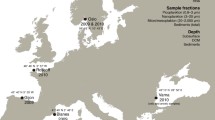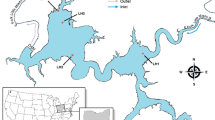Abstract
Organisms entering the East Sea (Sea of Japan) through the Korea Strait, together with water, salt, and energy, affect the East Sea ecosystem. In this study, we report on the biodiversity of eukaryotic plankton found in the Western Channel of the Korea Strait for the first time using small subunit ribosomal RNA gene (18S rDNA) sequences. We also discuss the characteristics of water masses and their physicochemical factors. Diverse taxonomic groups were recovered from 18S rDNA clone libraries, including putative novel, higher taxonomic entities affiliated with Cercozoa, Raphidophyceae, Picozoa, and novel marine Stramenopiles. We also found that there was cryptic genetic variation at both the intraspecific and interspecific levels among arthropods, diatoms, and green algae. Specific plankton assemblages were identified at different sampling depths and they may provide useful information that could be used to interpret the origin and the subsequent mixing history of the water masses that contribute to the Tsushima Warm Current waters. Furthermore, the biological information highlighted in this study may help improve our understanding about the complex water mass interactions that were highlighted in the Korea Strait.
Similar content being viewed by others
References
Beerenwinkel N, Günthard HF, Roth V, Metzner KJ (2012) Challenges and opportunities in estimating viral genetic diversity from next-generation sequencing data. Front Microbiol 3:329
Chun J, Lee JH, Jung Y, Kim M, Kim S, Kim BK, Lim YW (2007) EzTaxon: a web-based tool for the identification of prokaryotes based on 16S ribosomal RNA gene sequences. Int J Syst Evol Micr 57:2259–2261
DeLong EF (2009) The microbial ocean from genomes to biomes. Nature 459:200–206
Edwards JE, McEwan NR, Travis AJ, Wallace RJ (2004) 16S rDNA library-based analysis of ruminal bacterial diversity. Antonie Van Leeuwenhoek 86:263–281
Gamo T, Nakayama N, Takahata N, Sano Y, Zhang J, Yamazaki E, Taniyasu S, Yamashita N (2014) The Sea of Japan and its unique chemistry revealed by time-series observations over the last 30 years. Monogr Environ Earth Planets 2:1–22
Gilbert DG (1995) SeqPup, a biological sequence editor and analysis program for Macintosh computers. Indiana Univ, Bloomington
Gilbert JA, Dupont CL (2011) Microbial metagenomics: beyond the genome. Ann Rev Mar Sci 3:347–371
Guillou L, Viprey M, Chambouvet A, Welsh RM, Kirkham AR, Massana R, Scanlan DJ, Worden AZ (2008) Widespread occurrence and genetic diversity of marine parasitoids belonging to Syndiniales (Alveolata). Environ Microbiol 10:3349−3365
Jang MC, Baek SH, Jang PG, Lee WJ, Shin K (2012) Patterns of zooplankton distribution as related to water masses in the Korea Strait during winter and summer. Ocean Polar Res 34:37–51
Johnson DR, Boyer TP (2015) East Asian Seas regional climatology (Version 2). Dataset, National Centers for Environmental Information, NOAA. doi:10.7289/V5MP5171.
Karl DM, Proctor LM (2006) Foundations of microbial oceanography. Oceanography 20:16–27
Kim BK, Lee S-R, Lee JA, Chung IK (2010) Molecular monitoring of plankton diversity in the Seonakdong River and along the coast of Namhae. J Korean Soc Oceanogr 15:25–35
Kim E, Harrison JW, Sudek S, Jones MDM, Wilcox HM, Richards TA, Worden AZ, Archibald JM (2011) Newly identified and diverse plastid-bearing branch on the eukaryotic tree of life. P Natl Acad Sci USA 108:1496–1500
Klindworth A, Pruesse E, Schweer T, Peplies J, Quast C, Horn M, Glöckner FO (2013) Evaluation of general 16S ribosomal RNA gene PCR primers for classical and next-generation sequencing-based diversity studies. Nucleic Acids Res 41: e1. doi:10.1093/nar/gks808
Lee CR, Lee PG, Park C (1999) Seasonal and vertical distribution of planktonic copepods in the Korea Strait. J Korean Fish Soc 32:525–533
Lee S-R, Oak JH, Chung IK, Lee JA (2010) Effective molecular examination of eukaryotic plankton species diversity in environmental seawater using environmental PCR, PCR-RFLP, and sequencing. J Appl Phycol 22:699–707
Lee S-R, Rho TK, Oak JH, Lee JA, Lee TS, Chung IK (2012) Metagenomic examination of diversity within eukaryotic plankton from the Ulleung Basin in the East Sea of Korea. J Plant Biol 55:310–315
Lee WH, Shim JH (1990) Distribution of phytoplankton standing crop and associated T-S properties in the Southwestern East Sea (Sea of Japan). J Oceanol Soc Korea 25:1–7
Leser TD, Amenuvor JZ, Jensen TK, Lindecrona RH, Boye M, Møller K (2002) Culture-independent analysis of gut bacteria: the pig gastrointestinal tract microbiota revisited. Appl Environ Microb 68:673–690
Longhurst AR (1998) Ecological geography of the sea. Academic Press, San Diego, USA, 398 p
López-García P, Rodriguez-Valera F, Pedrós-Alió C, Moreira D (2001) Unexpected diversity of small eukaryotes in deep-sea Antarctic plankton. Nature 409:603–607
Lovejoy C, Potvin M (2011) Microbial eukaryotic distribution in a dynamic Beaufort Sea and the Arctic Ocean. J Plankton Res 33:431–444
Massana R, Castresana J, Balagué V, Guillou L, Romari K, Groisillier A, Valentin K, Pedrós-Alió C (2004) Phylogenetic and ecological analysis of novel marine stramenopiles. Appl Environ Microb 70:3528–3534
Massana R, Pedrós-Alió C (2008) Unveiling new microbial eukaryotes in the surface ocean. Curr Opin Microbiol 11:213–218
Medlin L, Elwood HJ, Stickel S, Sogin ML (1988) The characterization of enzymatically amplified eukaryotic 16S-like rRNA-coding regions. Gene 71:491–499
Min HS, Park JH, Choi AR, Park YG, Shin KS, Jang PG (2011) Observation of water property variation in the Western Channel of the Korea Strait during 2006−2010. Ocean Polar Res 33:325–336
Moon-van der Staay SY, De Wachter R, Vaulot D (2001) Oceanic 18S rDNA sequences from picoplankton reveal unsuspected eukaryotic diversity. Nature 409:607–610
Not F, Valentin K, Romari K, Lovejoy C, Massana R, Tobe K, Vaulot D, Medlin LK (2007) Picobiliphytes: a marine picoplanktonic algal group with unknown affinities to other eukaryotes. Science 315:253–255
Not F, del Campo J, Balagué V, de Vargas C, Massana R (2009) New insights into the diversity of marine picoeukaryotes. PLoS One 4:e7143
Nozaki Y, Tsubota H, Kasemsupuya V, Yashima M, Ikuta N (1991) Residence times of surface water and particle reactive 210Pb and 210Po in the East China and Yellow seas. Geochim Cosmochim Ac 55:1265–1272
Park MG, Cooney SK, Kim JS, Coats DW (2002) Effects of parasitism on diel vertical migration, phototaxis/geotaxis, and swimming speed of the bloom-forming dinoflagellate Akashiwo sanguinea. Aquat Microb Ecol 29:11–18
Pawlowski J, Audic S, Adl S, Bass D, Belbahri L, Berney C, Bowser SS, Cepicka I, Decelle J, Dunthorn M, Fiore-Donno AM, Gile GH, Holzmann M, Jahn R, Jirku M, Keeling PJ, Kostka M, Kudryavtsev A, Lara E, Lukes J, Mann DG, Mitchell EAD, Nitsche F, Romeralo M, Saunders GW, Simpson AGB, Smirnov AV, Spouge JL, Stern RF, Stoeck T, Wimmermann J, Schindel D, De Vargas C (2012) CBOL Protist working group: barcoding eukaryotic richness beyond the animal, plant, and fungal kingdoms. PLoS Biol 10:e1001419
Rusch DB, Halpem AL, Sutton G, Heidelberg KB, Williamson S, Shibu Y, Kongying W, Eisen JA, Hoffman JM, Remington K, Beeson K, Tran B, Smith H, Baden-Tillson H, Stewart C, Thope J, Freeman J, Andrews-Pfannkoch C, Venter JE, Li K, Kravitz S, Heidelberg JF, Utterback T, Rogers YH, Falcón LI, Valeria S, Bonilla-Rosso G, Luis EE, Karl DM, Sathyendranath S, Platt T, Bermingham E, Gallardo V, Tamayo-Castillo G, Ferrari Mr, Strausberg RL, Nealson K, Frazier M, Venter JC (2007) The Sorcerer II global ocean sampling expedition: Northwest Atlantic through Eastern Tropical Pacific. PLoS Biol 5:e77
Saitou N, Nei M (1987) The neighbor-joining method: a new method for reconstructing phylogenetic trees. Mol Biol Evol 4:406–425
Seenivasan R, Sausen N, Medlin LK, Melkonian M (2012) Picomonas judraskeda gen. et sp. nov.: the first identified member of the Picozoa phylum nov., a widespread group of picoeukaryotes, formerly known as “picobiliphytes”. PLoS One 8:e59565
Shon DH, Shin KS, Jang PG, Kim YO, Chang M, Kim WS (2008) Effect of thermal stratification and mixing on phytoplankton community structure in the Western Channel of the Korea Strait. Ocean Polar Res 30:261–275
Swofford DL (2001) PAUP*: Phylogenetic Analysis using Parsimony (*and other Methods). Ver. 4. Sinauer, Sunderland
Thompson JD, Gibson TJ, Plewniak F, Jeanmougin F, Higgins DG (1997) The CLUSTAL_X windows interface: flexible strategies for multiple sequence alignment aided by quality analysis tools. Nucleic Acids Res 25:4876−4882
Weisse T (2008) Distribution and diversity of aquatic protists: an evolutionary and ecological perspective. Biodivers Conserv 17:243–259
Yoon JM, Lee JE, Lee S-R, Rho TK, Lee JA, Chung IK, Lee TS (2012) Metagenomic approach on the eukaryotic plankton biodiversity in coastal water of Busan (Korea). J Korean Soc Oceanogr 17:59–75
Author information
Authors and Affiliations
Corresponding author
Rights and permissions
About this article
Cite this article
Lee, SR., Song, E.H. & Lee, T. Eukaryotic Plankton Species Diversity in the Western Channel of the Korea Strait using 18S rDNA Sequences and its Implications for Water Masses. Ocean Sci. J. 53, 119–132 (2018). https://doi.org/10.1007/s12601-018-0005-3
Received:
Revised:
Accepted:
Published:
Issue Date:
DOI: https://doi.org/10.1007/s12601-018-0005-3




